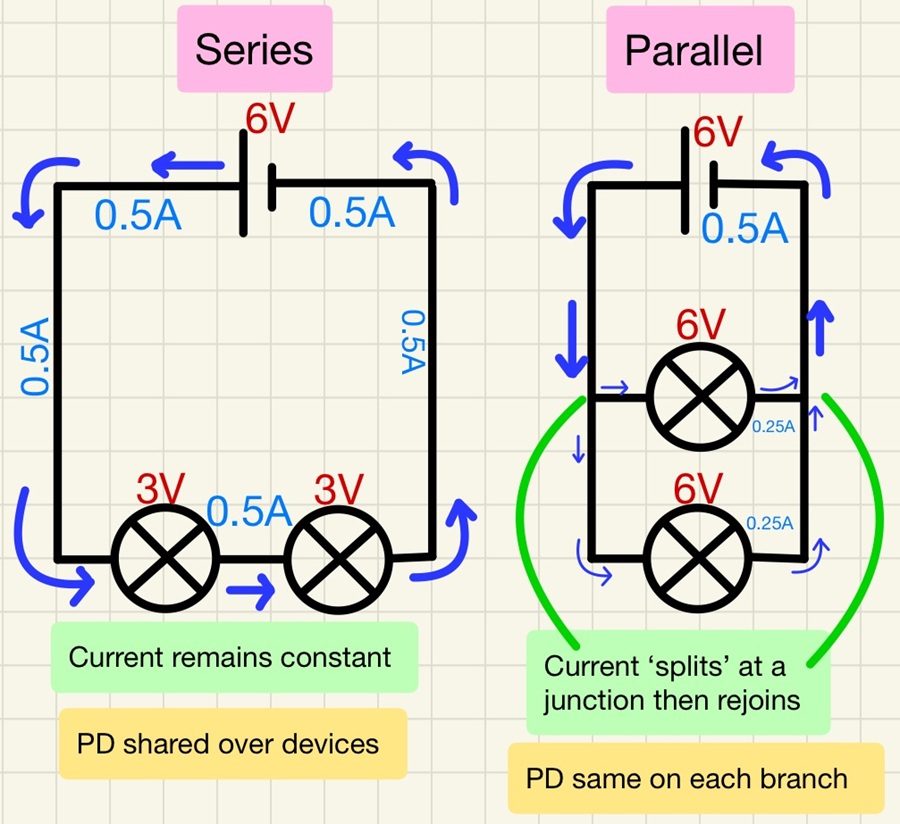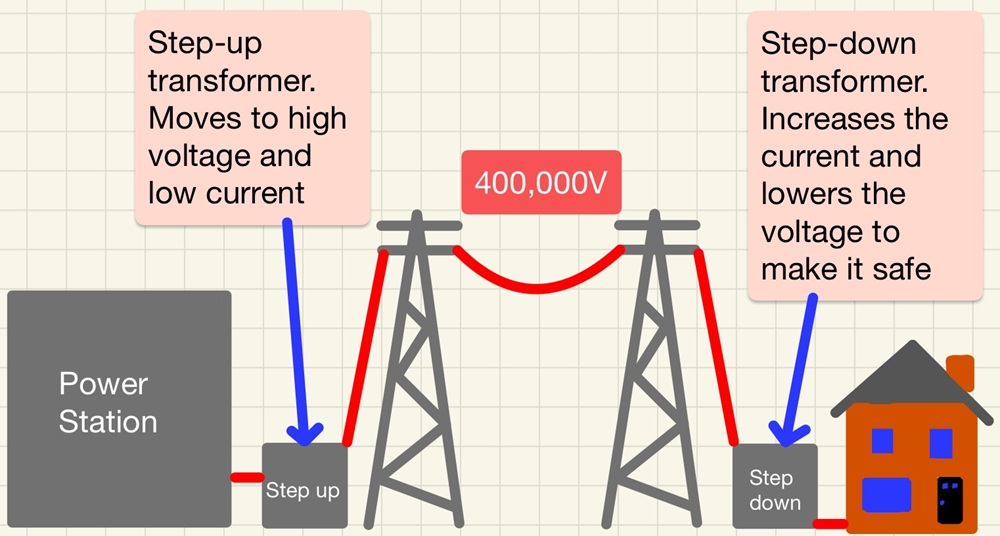Electricity
What we are learning:
Drawing circuits:

In order to succeed in this part, you need to learn the names and symbols of the circuit components. You must be able to draw an ammeter and voltmeter in their correct orientation (series/parallel) and finally, ensure accuracy with your diagrams, wires must meet so that circuits are complete.
Current and charge:

Current is caused by the flow of electrons. Electrons have a charge so a current is a flow of charge. The more electrons that flow through the wire, the bigger the current. These can be quantified using the following equation:
Charge (C) = current (A) x time (s)
Q = It
Units - C is coulombs and A is amperes or amps.
Series and parallel circuits:

Series circuits: As the components are in a line, the current through all of them is the same. The potential difference is shared amongst the components and they add up to the potential difference across the cell/battery. Parallel circuits: As there are branches in the wires, the current can flow in different paths and prefers to flow down the easiest route. This means that, unlike with series circuits above, the current is shared amongst the routes but the potential difference on each branch is the same.
Potential difference, current & resistance:

Potential difference (V) is how much pushing the battery does, the current (A) is how much charge is flowing and the resistance (Ω) is how difficult it is for the charge to flow. The relationship between these three can be expressed in this formula:
Potential difference (V) = current (A) x resistance (Ω)
V = IR
There is a required practical in which you need to investigate resistance including factors such as changing the length of a wire at constant temperature.
Ohm's law:

Ohm's law states that the current through a conductor is directly proportional to the potential difference at a constant temperature. Basically, as you increase the voltage, the current goes up as long as the wire stays at the same temperature.
You need to know that a filament bulb does bot have a directly proportional relationship, this is because as the current increases in the filament, the temperature will increase which increases the resistance. Other components don't follow Ohm's law: LDRs (light dependent resistors), thermistors and diodes all have specific resistances depending on outside conditions.
• LDR has higher resistance in the dark and it decreases as it gets lighter.
• A thermistor's resistance decreases as they get warmer.
• A diode has a very high resistance in one direction but not in the other.
You will investigate IV characteristics in a required practical to see different devices and their behaviours.
Finally, in a series circuit, the resistance of each component can be added to find the total resistance in the circuit. In a parallel circuit, the total resistance: 1/Rtot = 1/R1 + 1/R2 + 1/R3
Domestic electricity:

At home, our electricity arrives as AC, this is alternating current which means that the current swaps direction regularly. Here, the frequency of change is 50 times per second or 50 Hz. In the UK, the potential difference is 230 V and the current depends on the power of the device it supplies.
In the great British plug, there are three wires:
• Brown - live wire (carries AC supply)
• Blue - neutral wire (completed the circuit)
• Yellow/green stripes - earth wire (prevents the appliance from becoming live) (stripes make it obvious even to colour blind people).
If there is a fault, the current flows through the earth wire. As there is so little resistance this way, a large current can flow. Because of this, safety features detect this large current and break the circuit:
Traditional fuses: Inside the fuse is a thin wire that is designed to operate at the current needed for the device to work normally (1A, 3A, 5A or 13A). If an excess current flows (to earth during a fault), the wire inside the fuse becomes so hot that the wire melts and the circuit is broken.
Residual Current Circuit Breaker or RCCB: These detect the differences between the live and neutral wires' currents. If they differ by a tiny amount, the switch "trips" and breaks the circuit. RCCBs are much more preferred as they are more sensitive and when they have done their job, you can repair the fault and reset them instantly, whereas fuses need to be replaced.
Electrical power:

Power, as we have seen before, is a measure of how quickly energy is transferred from one store into another. Here we are looking at any transfer that occurs in an electrical device and there are two main ways of doing this. The first is using this formula:
Power (W) = potential difference (V) x current (A)
P = VI
Using this, formula, you can clearly see the power of an electrical appliance by simply multiplying the current by 230 V. More useful than that, suppose you have a 60 W bulb in a lamp, you can work out how much current it draws from the supply. Rearrange P = VI to I = P/V so 60 W/230 V = 0.26 A. This is particularly important so that you can select the appropriate fuse. Using a 1 A fuse is best here as the current only needs to raise by 0.74 A and the wire inside will melt and break the circuit, if you selected a 13 A fuse, then the current would have to rise by 12.74 A before the circuit breaks which is far more dangerous. The energy transferred by an appliance can be increased by having a greater power or by running for a longer time.
The next formula is Power lost as heat(W) = current2 (A) x resistance (Ω)
P = I2R
This second formula is particularly useful in explaining why high voltage/low current electricity transfer on pylons in the national grid have low resistance to less energy lot as heat.
There are clear links between energy and work done. We know that 1 watt is one joule transferred every second so we can put that into a new formula:
Energy (J) = power (W) x time (s)
E = Pt
We can also link this to an equation that we met earlier, Q =It and generate this:
Energy (J) = charge (C) x potential difference (V)
E = QV
The National grid:

Once the power cables leave the power station generators, the national grid starts and delivers the electricity to your home. The start is the step-up transformers, here the potential difference is raised to between 275000 V and 400000 V and the current is dropped to very low levels. This is because, as seen in the last topic, using P = I2R, If the current is very low then the power lost (as heat) is also low. In order to keep the power to homes the same, as P=VI, as I falls, V must go up. Large potential differences can be more dangerous but without them, most of the energy would have dissipated by the time it gets to your house and you would not be able to run devices normally. Before getting into your home, a step-down transformer will bring the potential difference back to 230 V.
In residential areas, you will see fewer "above ground" cables such as those on pylons as they are buried under ground, this looks better but it is more expensive to do as roads etc need to be dug up and there is mor of a risk of somebody digging through a cable. The National Grid is currently removing pylons from areas of outstanding natural beauty and burying the cables in tunnels to make it more visibly appealing.
Key words/terms for this topic
Alternating Current Alternating potential difference Ampere Charge Charge flow Coulombs Current Diode Direct Current Direct potential difference Electrostatic force Fuse Light dependent resistor (LDR) National grid Ohmic Conductor Parallel Circuit Potential Difference Residual Current Circuit Breaker (RCCB) Resistance Series Circuit Short circuit Step-down transformer Step-up transformer Thermistor Transformer Voltage
Curriculum Health Check:
Q: Describe the p.d. in a series circuit.
A: The p.d. of the power supply is half that of all of the components
B: The p.d. of the power supply is the same as in each of the components
C: The p.d. of the power supply is shared between the components
D: The p.d. of the power supply is double that of all of the components
What you need to know
You need to learn the circuit diagram components, don't forget the more difficult ones like: LDR and thermistors. Circuits must be closed for current to flow, this current is a flow of charge and it can be calculated using:

Charge flow = current x time or Q= I t

Charge is in Coulombs (C), current in Amperes (A) and time in seconds (s).

Current is impeded by the resistance of each component, this can be calculated using V=I R, The potential difference in volts is equal to the current flowing through multiplied by the resistance in ohms (Ω).

Required practical 15: Using circuit diagrams, construct circuits to investigate the factors that affect resistance in a circuit.

Resistors have a constant value in ohms (Ω) so as the PD increases, so does the current, however, in real life devices such as bulbs warm up so the resistance increases to the graphs are no longer straight lines. Current only flows in one direction through a diode. R for a thermistor decreases as temperature increases and they can be used as thermostats. The R in a light dependent resistor (LDR) decreases and light levels increase, these can be used to turn lights on when it gets dark. You need to be able to design circuits, explain what happens in these conditions and calculate V, I, R and Q.

Required practical 16- Construct circuits to investigate the I-V characteristics of components like filament lamps, diodes and resistor.

Series circuits have all of the components in a line with no branching wires. The current is the same through every component, however, the PD drops at each component and the total is equal to that of the power supply. Resistance in a series circuit can be measured by:

Rtotal = R1 + R2 + R3

In a parallel circuit, the potential difference across each component is the same as the power supply, however, the current varies. The total current through each branch is equal to the current through the power supply.

You need to be able to draw circuits and check other drawn circuits, add components in the correct places (ammeter in series, voltmeter in parallel) and describe the differences between series and parallel. Explain how resistance varies in series and parallel and finally, complete all of the calculations. You will only be expected to calculate the resistance in a series circuit, not a parallel one.

Domestic electricity in the UK is 230V alternating current (ac) which has a frequency of 50 Hz. Ensure that you can describe the differences between dc and ac current. Mains electricity at home has colour coded wires to help to increase safety.

• Live = brown

• Neutral = blue

• Earth = yellow and green stripes.

You should be aware of the dangers of electricity and the safety features that are available - fuses, RCCBs etc.

Electrical power is the rate of transfer of energy, the power of an appliance can be measured using these equations:

Power (W) = potential difference (V) x Current (A) or P=VI

Power (W) = Current2 (A) x Resistance (Ω) or P= I2R

Work is done when charge flows, it then transfers energy to heat or kinetic energy in the appliance. The energy increases if the appliance is left on longer or has a higher power output. You need to be able to calculate the total energy transferred:

Energy (J) = Power (W) x time (s) or E=Pt

Energy (J) = Charge flow (Q) x Potential Difference (V) or E=QV

Our National Grid is the means of transporting electrical power from a power station to our homes. It begins with step-up transformers which increase the voltage and decrease the current to reduce energy loss as heat in the wires. Step down transformers return it to the safe levels that we have at home.

Extra topics needed for the Higher Tier papers:

When describing the transformers used in the national grid, you need to be able to calculate an unknow from this equation which you are given:

PDprimary coil x Iprimary coil = PDSecondary coil x ISecondary coil

This shows that the power going into a coil is equal to the power coming out. If you rearrange this, you will be able to make the unknown quantity the subject of the equation and calculate its answer.

This page was updated on: 3rd April 2024

